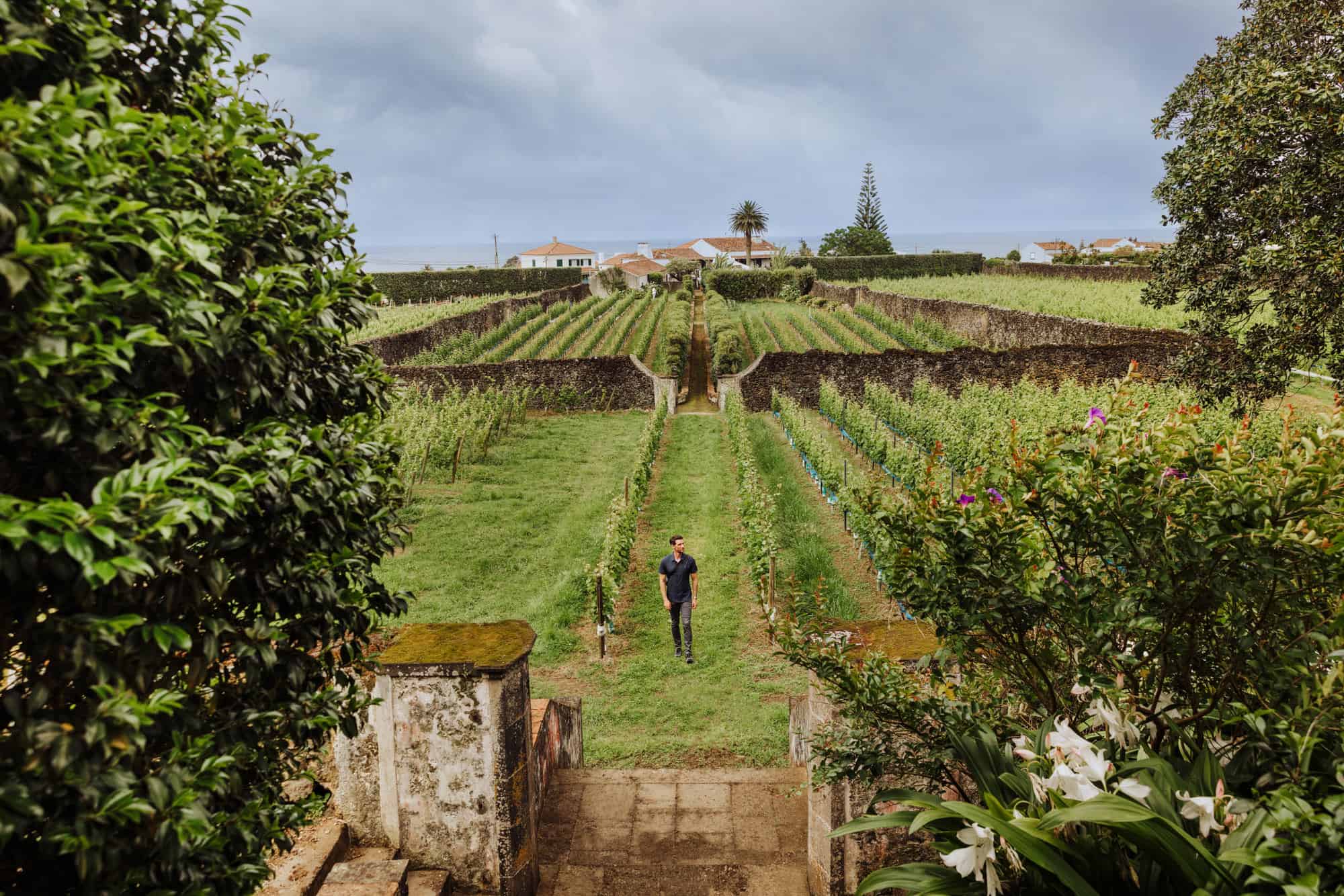Azores Wine: Vineyards, Wineries, Tastings, and Tours

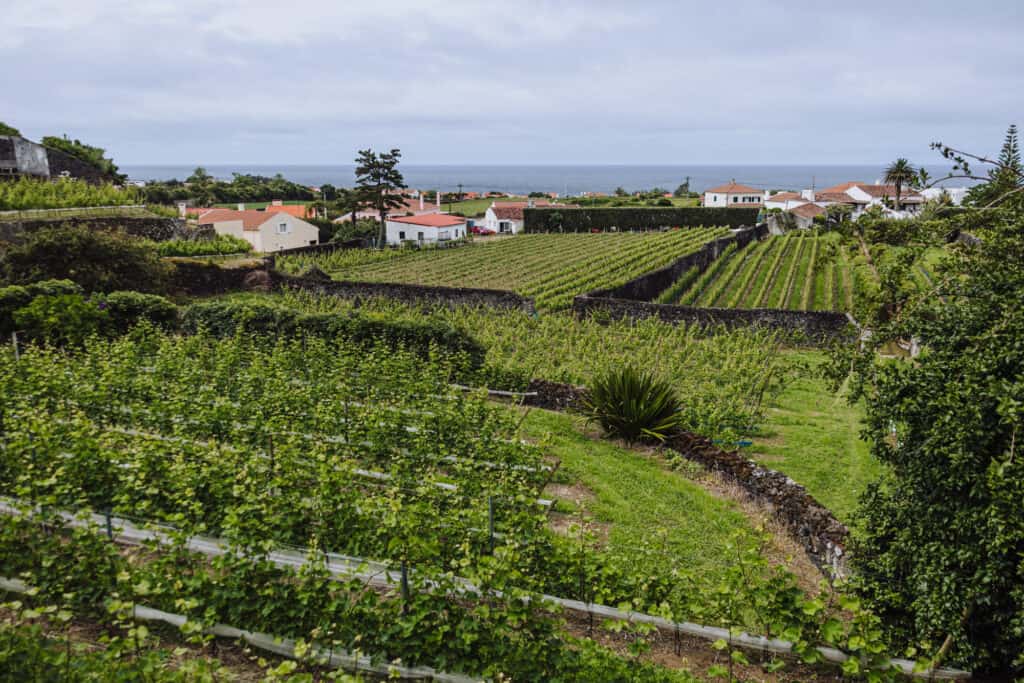
BY JARED DILLINGHAM
AZORES WINE: VINEYARDS AND WINERIES ON THE ISLANDS
While not as renowned as other wine regions, the Azores do have a small but thriving wine industry, with vineyards scattered across several of the islands.
The Azores’ wine production is centered around the islands of Pico, Terceira, and Graciosa. Pico Island, in particular, has a long history of winemaking and was designated a UNESCO World Heritage Site in 2004 due to its distinctive vineyard culture.
In recent years, there has been a renewed interest in the different Azorean / Azores wines, both domestically and internationally. Winemakers have been experimenting with new techniques and investing in modern equipment to improve the quality of their wines.
I’ll give an overview of the vineyards and wineries on all of the islands, but focus on São Miguel since it’s the easiest to get to and the most popular with tourists.
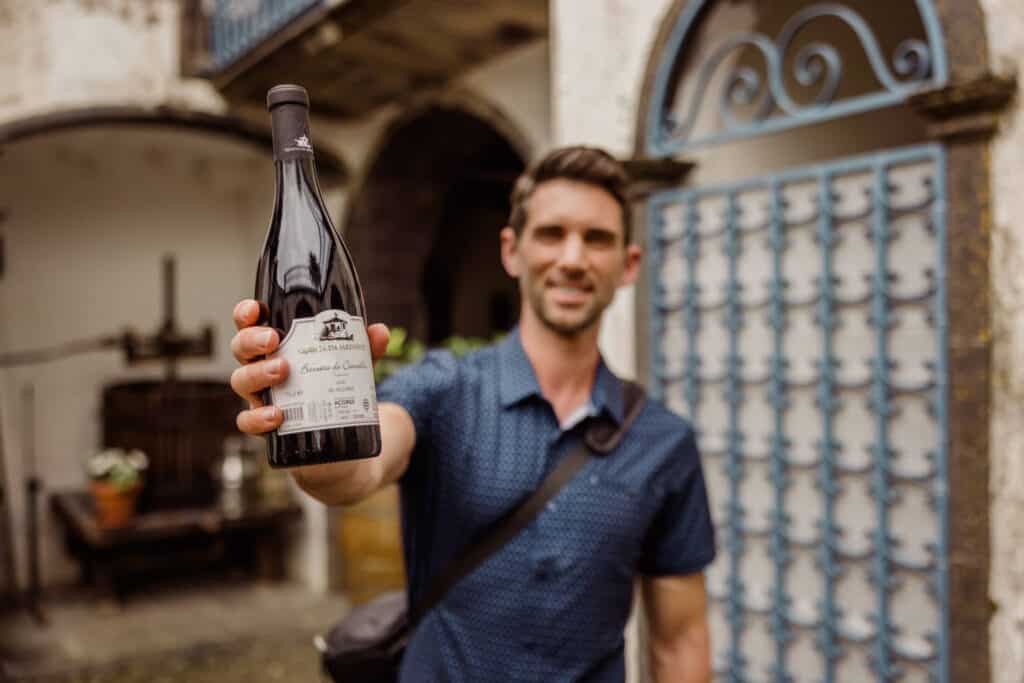
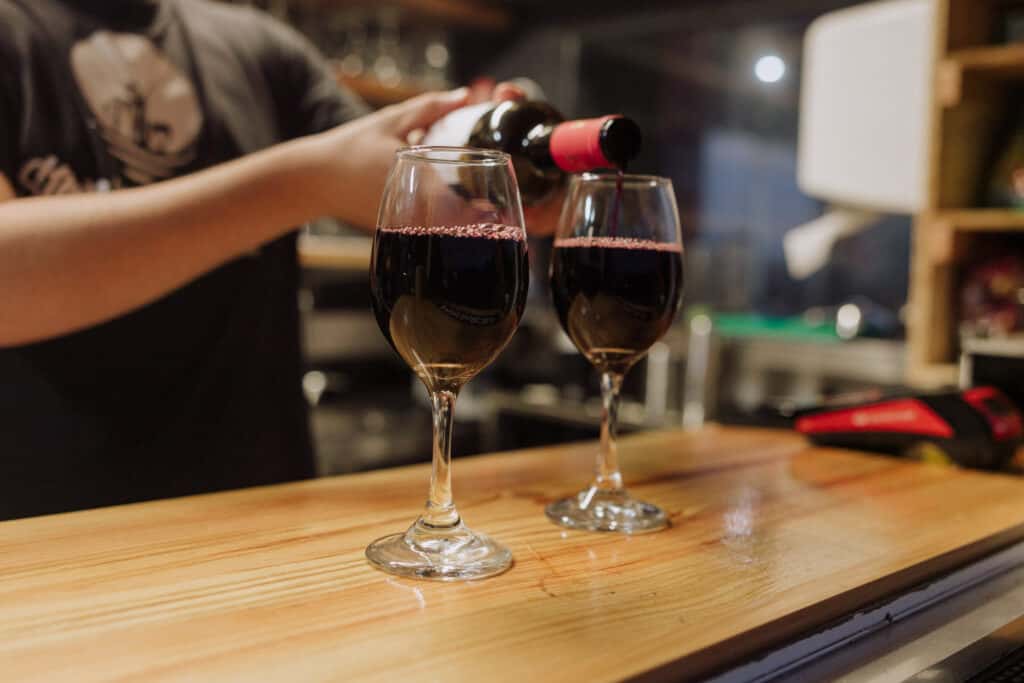
Azores Wine Tours
There are a few different wine tours to choose from in the Azores. Most of them are on the islands of Terceira and Pico.
Terceira Island Wine
🍷 Click to Book: Volcanic Wine Tasting
- An Azorean family in Praia da Vitória hosts a wine-tasting garden party.
🍷 Click to Book: Private Azores Wine Tour
- A guide will take you on a private afternoon tour of a winery and cellar.
🍷 Click to Book: Azores Winery Tour
- Learn about a local winery and sample its wines.
Pico Island Wine
🍷 Click to Book: Vineyard Tour & Wine Tasting
- Learn about wine-making and taste the local wines.
🍷 Click to Book: Private Azores Wine Tour
- Half-day private tour and tastings takes you to the village of Lajido de Santa Luzia.
São Miguel Wine
🍷 Click to Book: Azores Wine and Cheese Tasting
- An Azorean wine and cheese sampling in Ponta Delgada.
🍷 Click to Book: Wine Tour in Ponta Delgada
- A walking tour with wine tastings in the city.

Making Wine in the Azores
The mild climate and volcanic soil in the Azores are generally considered favorable for wine production.
Climate in the Azores
The Azores have a maritime climate with mild temperatures, high humidity, and rainfall throughout the year.
The moderate temperatures and cooling ocean breezes contribute to slower grape ripening and the retention of acidity in the grapes, which can result in wines with vibrant freshness. Many of the wineries on the islands are near the coastline.
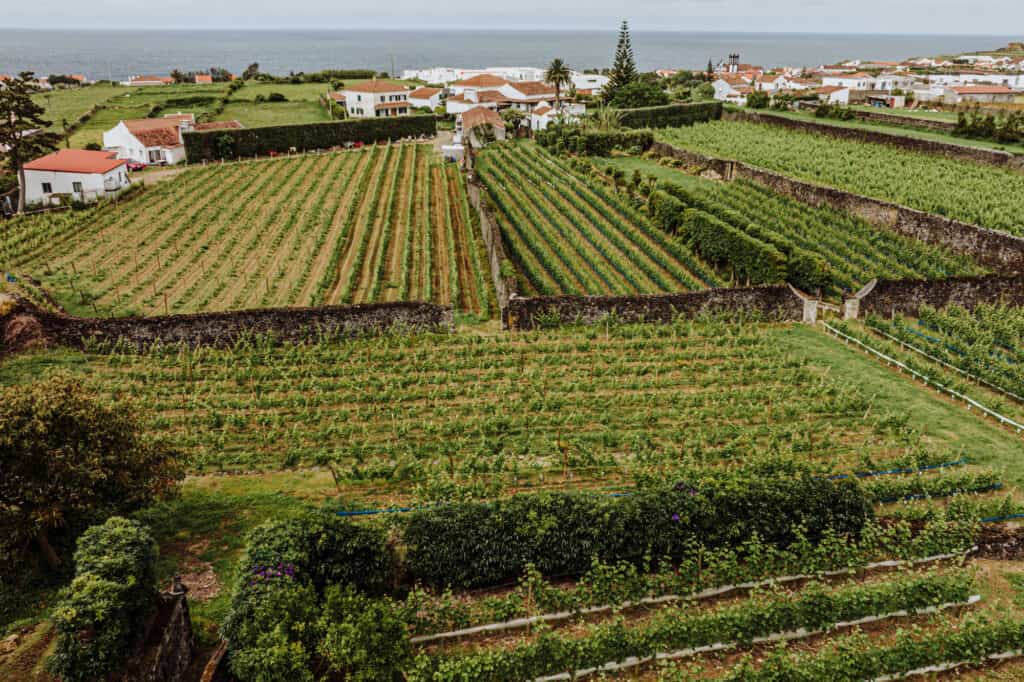
Soil in the Azores
The Azores have volcanic soil, which is generally fertile and rich in minerals, with good drainage. Different islands in the Azores have varying types of volcanic soil, ranging from basaltic to trachytic soils, which can further influence the wine’s profile.
Topography in the Azores
The Azores islands often feature hilly and mountainous landscapes, which provide opportunities for terraced vineyards. These terraces help control erosion, maximize sun exposure, and create microclimates for the grapevines.
Grape Varieties for Wine in the Azores
The main grape variety cultivated in the Azores is Verdelho, a white grape known for producing crisp and aromatic wines. Other grape varieties grown in the Azores include Arinto, Terrantez, and Merlot.
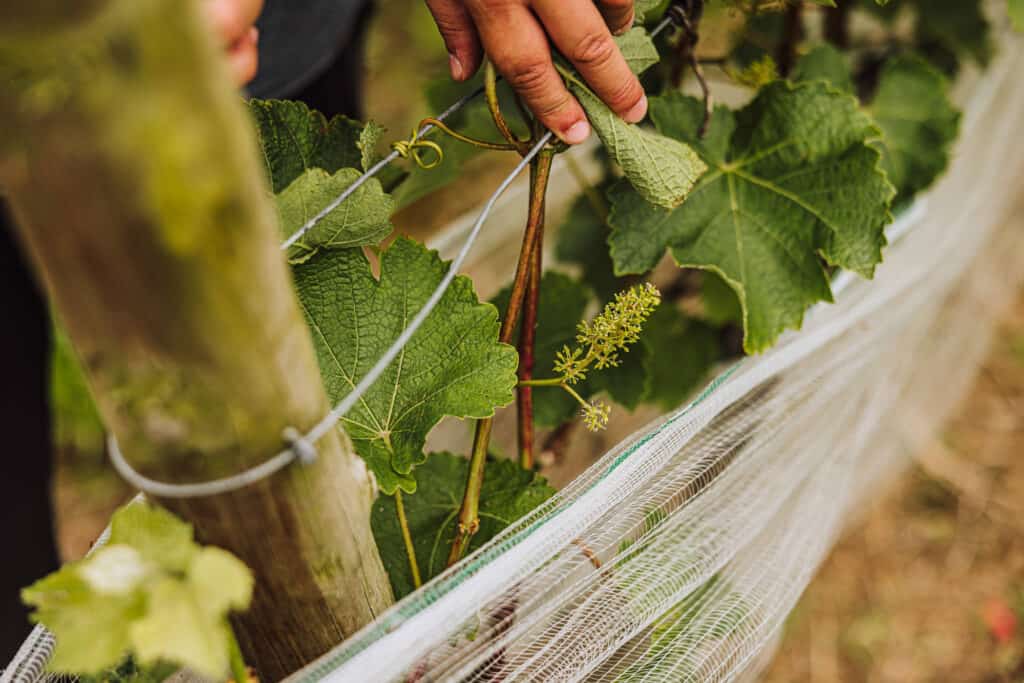
The Azores Wine Company
The Azores Wine Company was established in 2014 with the goal of reviving and promoting the ancient tradition of winemaking in the Azores, which dates back to the 15th century.
Stay at the Azores Wine Company Hotel
Incredibly, you can rent beautiful apartments at the Azores Wine Company!
➡️ Click to Book: Stay at the Azores Wine Company
The Azores Wine Company works with traditional grape varieties that are native to the islands, such as Verdelho, Arinto dos Açores, and the nearly extinct Terrantez do Pico.

The winemaking process at the Azores Wine Company emphasizes minimal intervention and sustainable practices. Grapes are harvested by hand, and fermentation occurs with native yeasts. The wines are often described as vibrant, fresh, and mineral-driven.
The Azores Wine Company produces a range of white, red, and rosé wines. Some of their notable wines include “Vulcânico,” a white wine made from Verdelho grapes, and “Tinto Vulcanico,” a red wine crafted from a blend of native grape varieties.

Visit the Azores Wine Company
In addition to their commitment to winemaking, the Azores Wine Company also plays an active role in promoting wine tourism in the Azores. They offer tours and tastings, allowing visitors to experience the unique beauty of the vineyards and learn about the winemaking process firsthand.
Azores Wine: São Miguel Island
Wine production on São Miguel Island, the largest island in the Azores, has gained increasing recognition in recent years. It’s home to a family-run winery that’s growing in popularity.
Quinta da Jardinete
Quinta da Jardinete is the largest vineyard on São Miguel Island.
From downtown Ponta Delgada, it’s a 20-minute drive north to the vineyards and winery at Quinta da Jardinete.
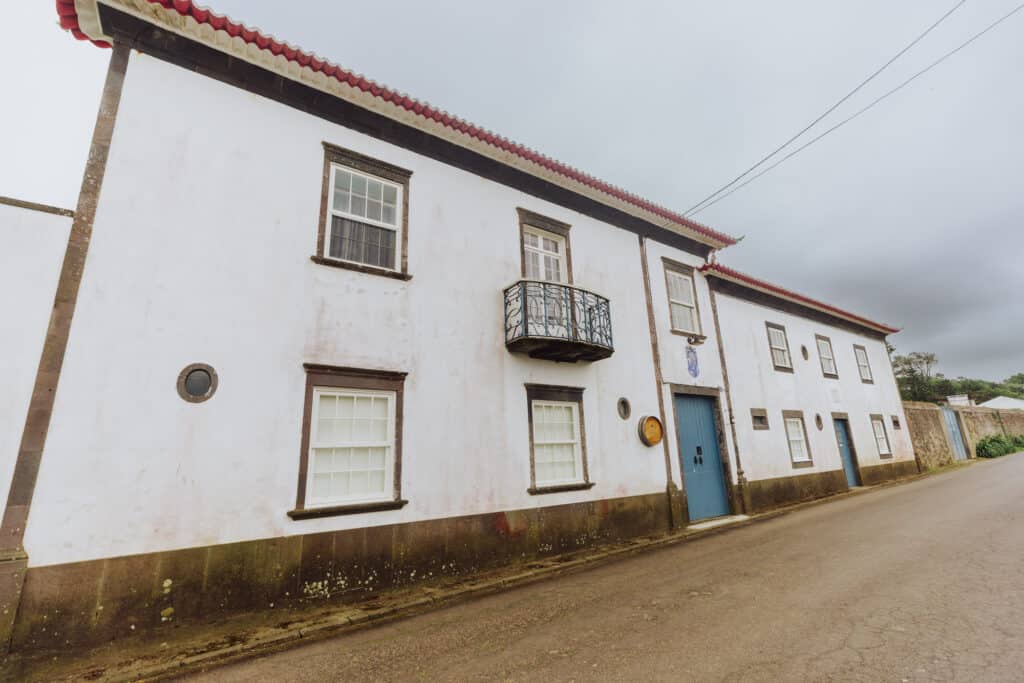
There’s no flashy entry or large sign to draw your attention to the winery. It’s clear from the moment you pull up on this rural neighborhood street: this is a small, family-run Azores wine operation!
It’ll make for one of your most memorable stops on a visit to the Azores.
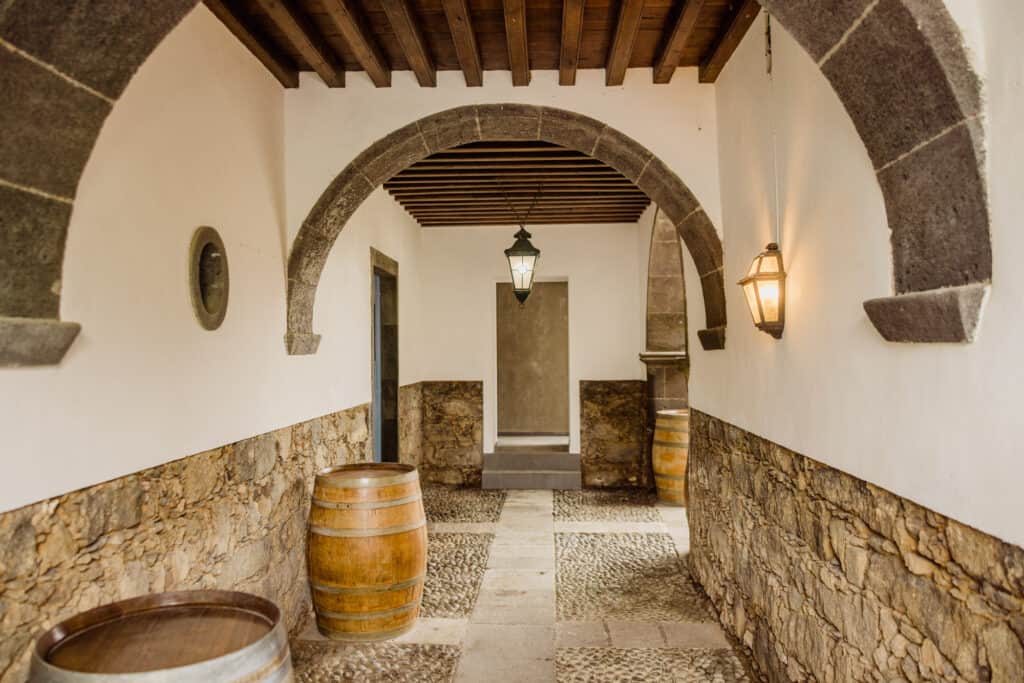
History of Quinta da Jardinete Winery in the Azores
The property the winery sits on has been inhabited for 200 years. In the 1800s, it was a citrus farm, growing oranges to export to England.
The “jardinete” that gives the winery its name is a perch on a hill above the main house with a view of the Atlantic Ocean and the north shore of São Miguel. One of the workers was stationed in the jardinete as a “lookout.” He’d whistle to the crew in the fields when he spotted a ship on the horizon, and together they’d hustle to load wagons full of oranges to bring to the harbor to sell.
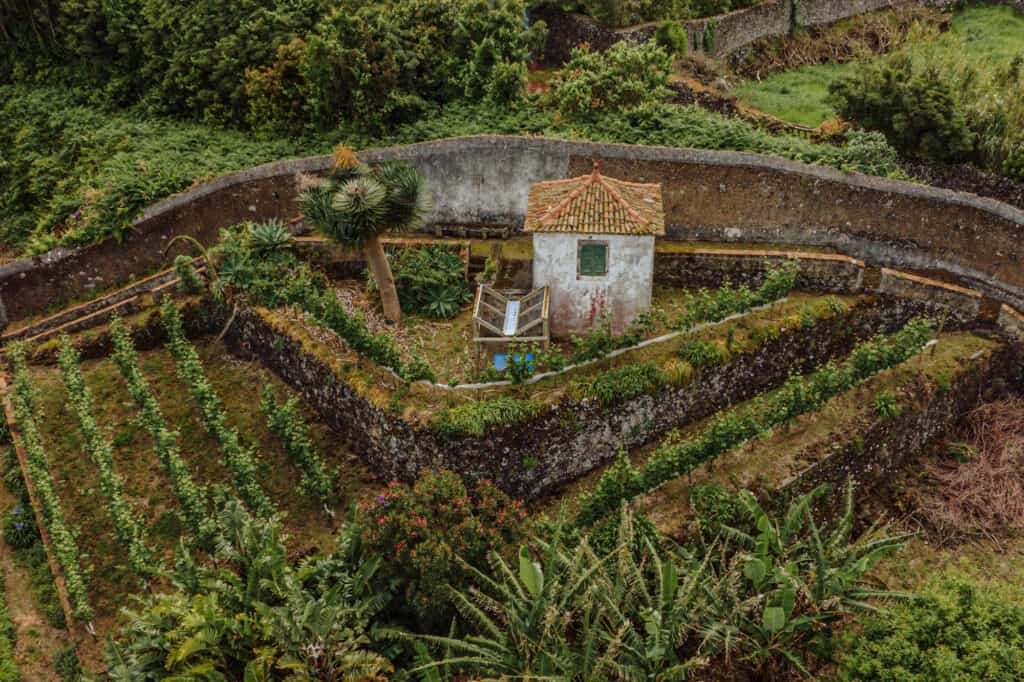
Orange exports to London ended more than a century ago, in the early 1900s, and the property was largely abandoned.
Eventually, a local Azorean man and his Austrian wife bought the property and began restoring the house.
They spotted avocado trees, banana trees, and random vines still thriving on the overgrown old farm property. The couple thought the soil and climate must be good enough to grow other kinds of vines, like grapes.
Bananas and other crops still grow in the vineyard today, alongside the grapes.
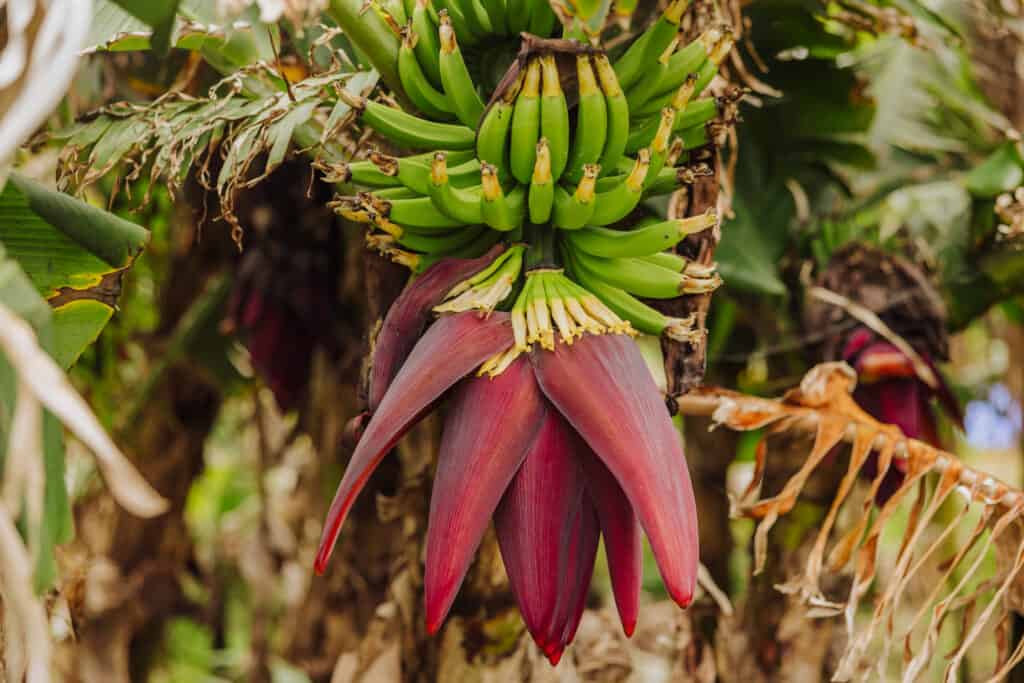
The owners of Quinta da Jardinete imported vines from Europe and began experimenting with grapes and wines. In 2005, they produced their first wines, and they’ve been growing for the last 20 years or so.
It takes three years for a grapevine to produce quality fruit for wine, so it’s a very slow process.
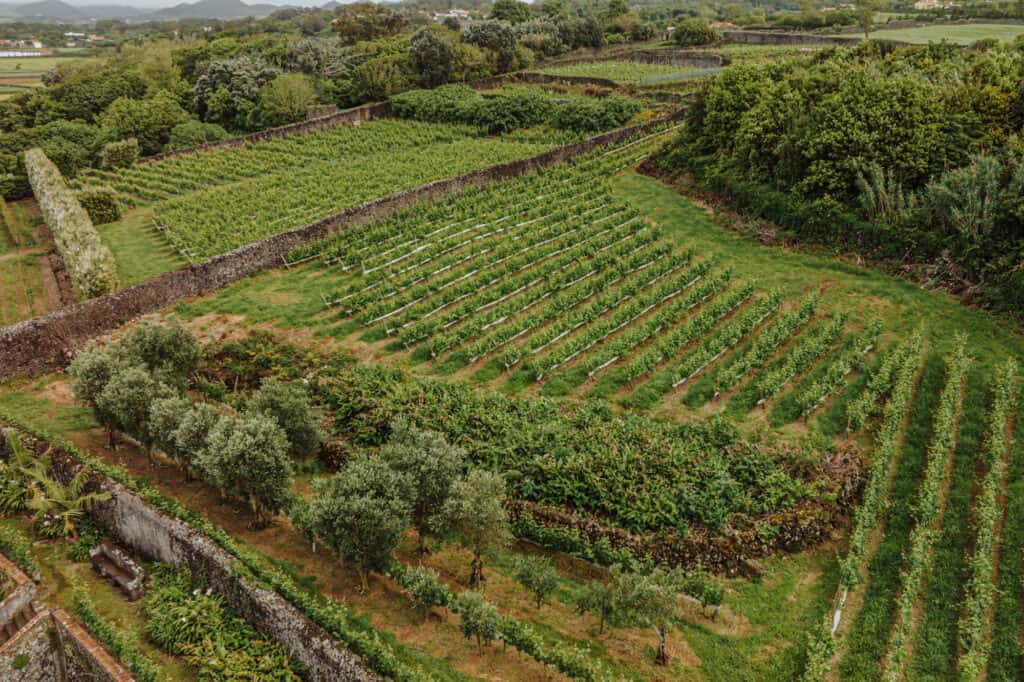
Challenges of Making Wine in the Azores
The weather is unpredictable in the Azores. While it never snows, the seasonal rains can be too strong or too light.
In 2022, heavy fog and colder-than-normal temperatures in the Azores stunted the vines. Too little sun and too much humidity led to the loss of 30% to 40% of Azores wine production that year.
Staffing in general is more of a struggle today on the farms and vineyards in the Azores.
The Quinta da Jardinete Winery operates with a staff of three people. They work in the fields with the vines in the morning and early afternoon, before switching over to do tours by 3:00pm.
They bring family members in for the grape harvest each year, and together they cover the 12 acres of crops on the property.
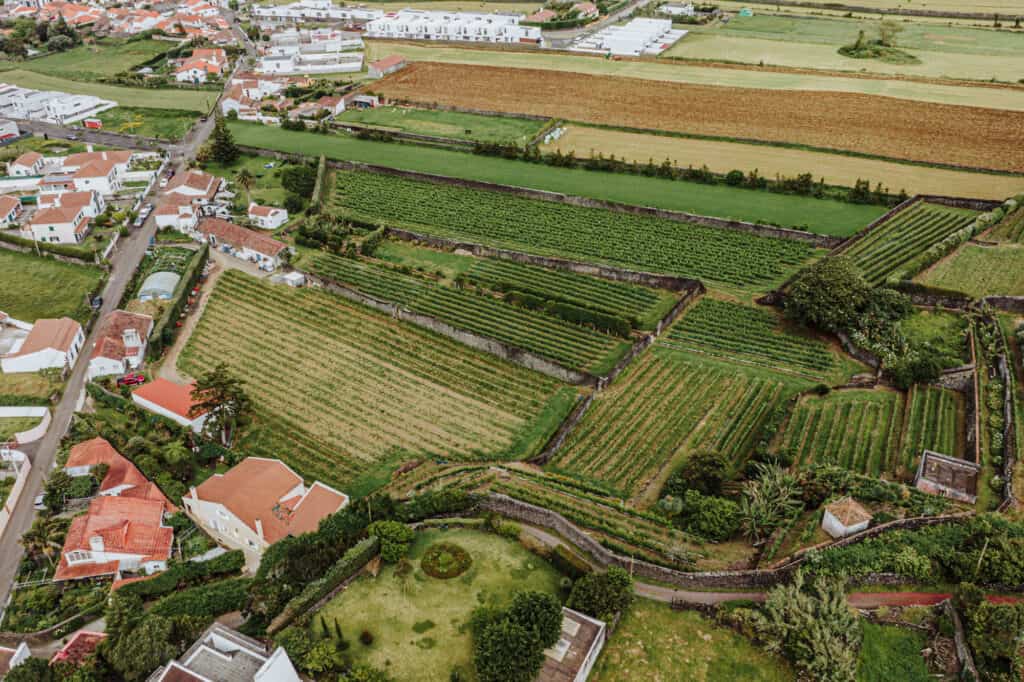
Quinta da Jardinete: The Modern Day Azores Winery
The owners of the winery stopped using herbicides and pesticides on their vines. They use sulfur spray and other natural remedies to take care of any fungus that grows on the leaves.
Roses are planted at the end of the rows of grapevines. In the US, we’d consider them like “the canary in a coal mine.”
The roses are more sensitive to diseases and other growing problems. They’re used to warn the staff at the vineyard if something is wrong before it overly impacts the grapes.
To deal with seasons of heavy rainfall, they planted grass between the rows of grapevines to soak up the excess moisture.
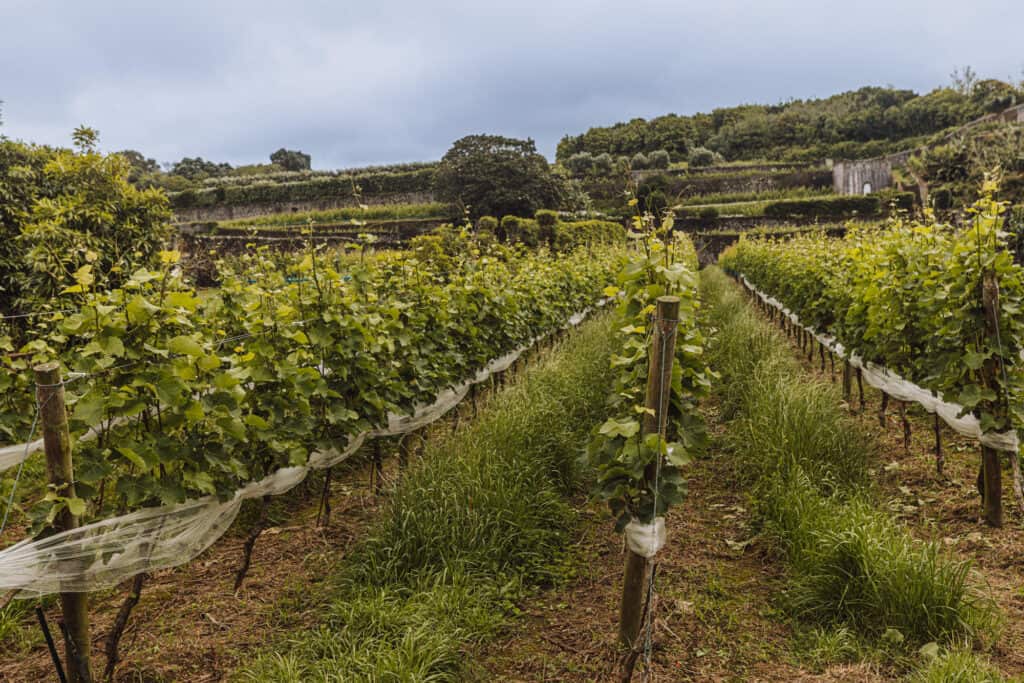
They have sticky traps set out to catch bugs, but their most laborious invention deals with birds (the worst pests at the winery).
They pull nets up around all of the vines in June and July, as soon as the grapes change color and become enticing to the birds. It’s a lengthy process, which takes a full six weeks to accomplish across all 12 acres at the vineyard.

I also found it fascinating to learn that the towering old rock walls serve a climate-control purpose at the vineyard.
The rocks absorb heat during the summer and release it at night, acting like a greenhouse surrounding the fields of grapevines.
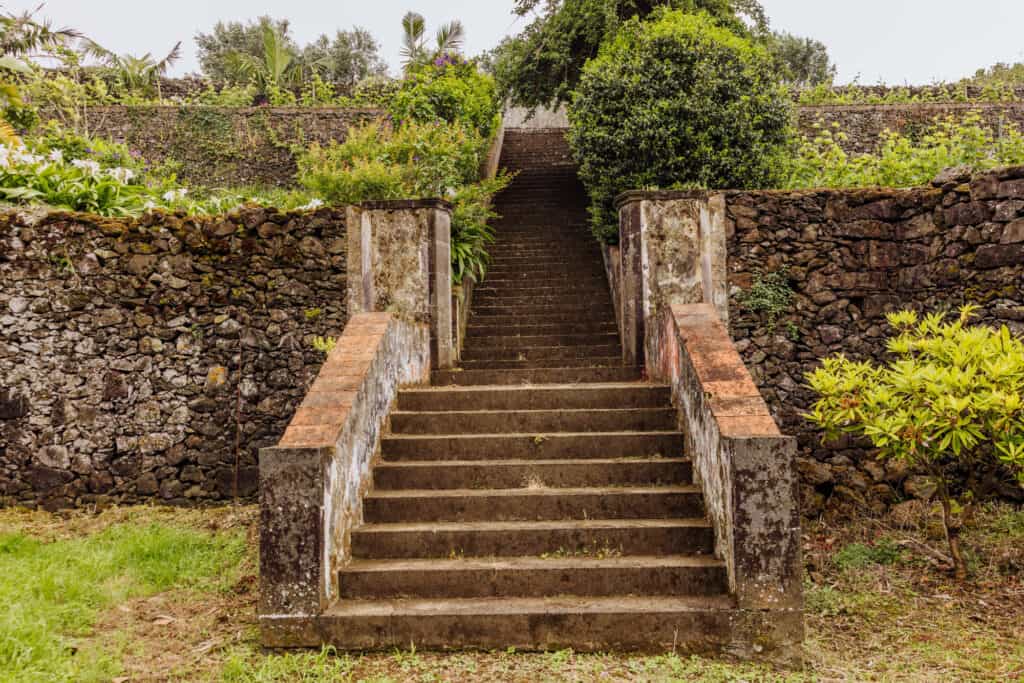
We found beehives at the back of the vineyard. There are apparently far fewer bees in the Azores these days, which is a problem farmers all over the world are facing.
The owners of the vineyard brought the bees in to pollinate the vines and other trees all over the property.
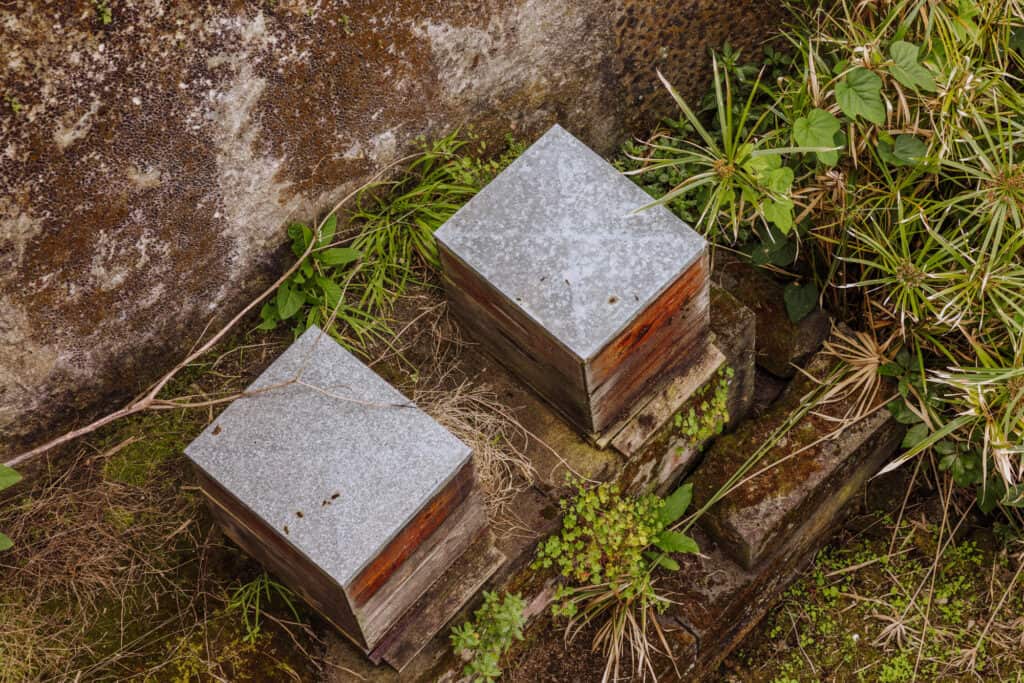
They grow onions, potatoes, and other crops between the vines to help fertilize the soil.
Wines Made Today
Quinta da Jardinete produces between 16,000 and 18,000 bottles of wine per year. They include several kinds:
- Pinot Grigio
- Pinot Noir
- Chardonnay
- Merlot
- Cabernet Franc
- Portuguese Red
They’ve divided up their crops to make:
- 50% red wines
- 40% white wines
- 10% rose wines
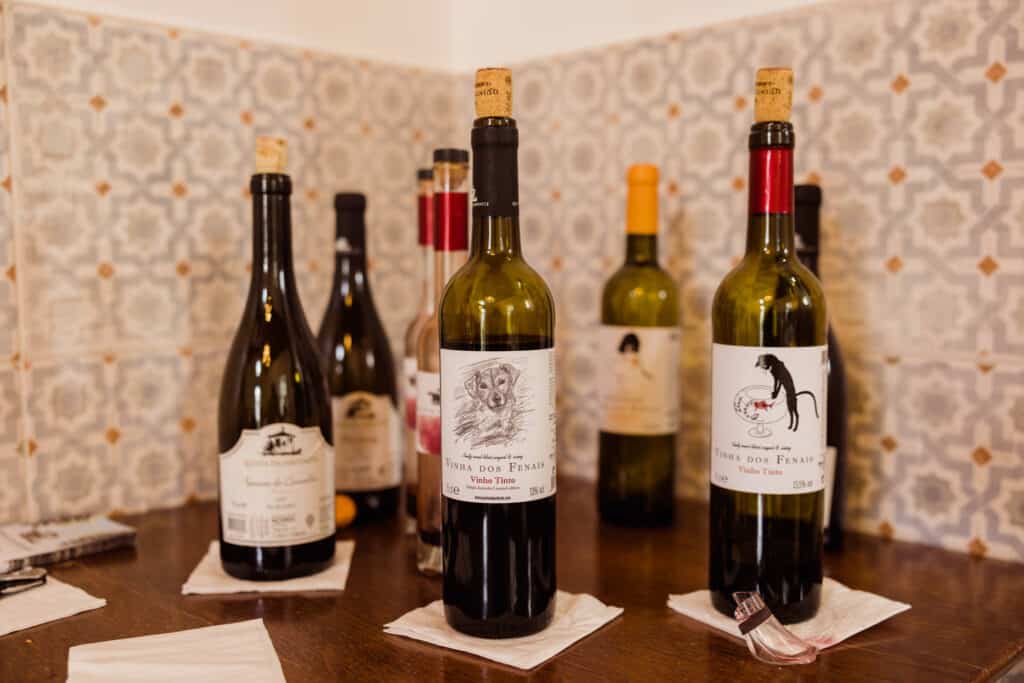
Tour Quinta da Jarinete Winery
An old chapel on the property has now been converted into a tasting room at the vineyard. You’ll also get to meet the friendly winery dog, Seda.
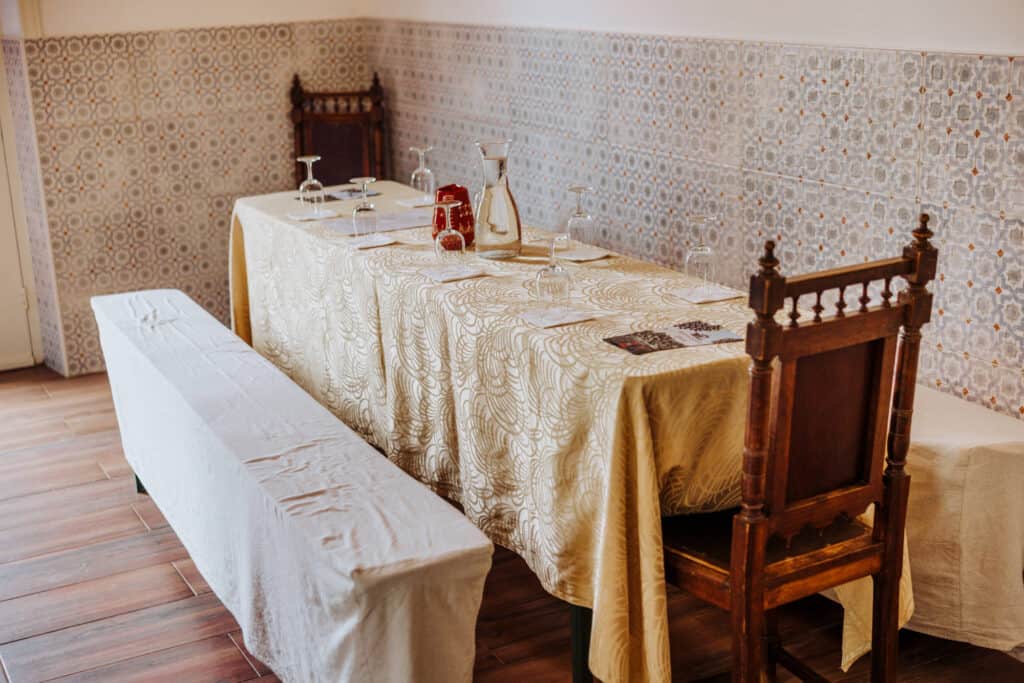
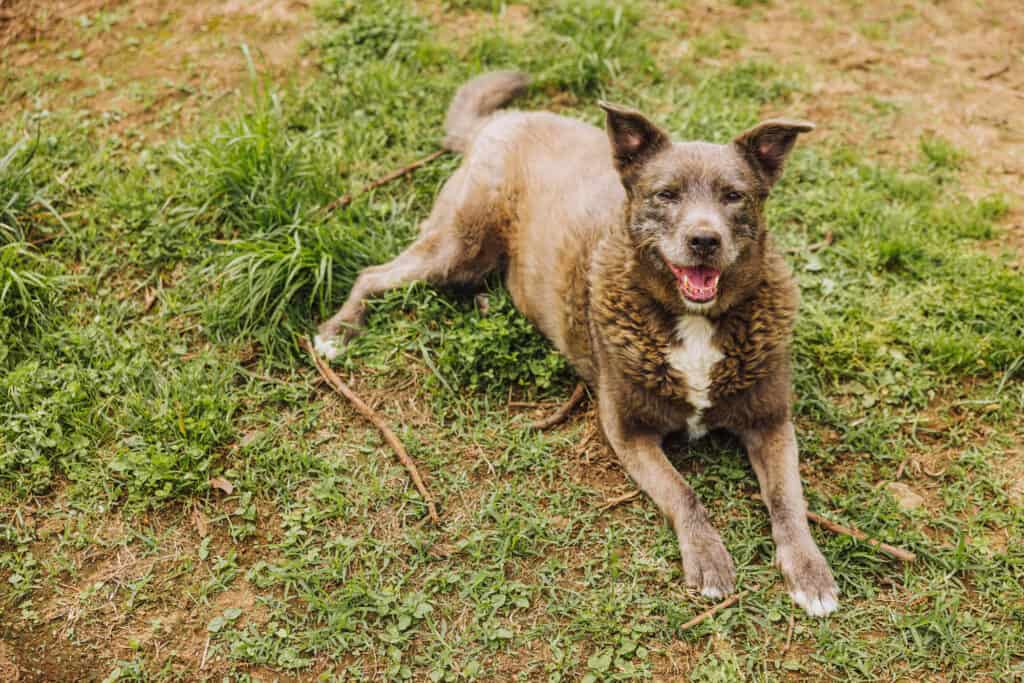
A tour plus the wine tasting is 7.50 Euros, plus 3.50 Euros for each additional glass.
They offer tours Monday through Friday, whether it’s a single person or a group.
It’s best to give them a heads-up that you’re coming:
- www.quintadajardinete.com
- QJardinete@gmail.com
- 351-968-617-382
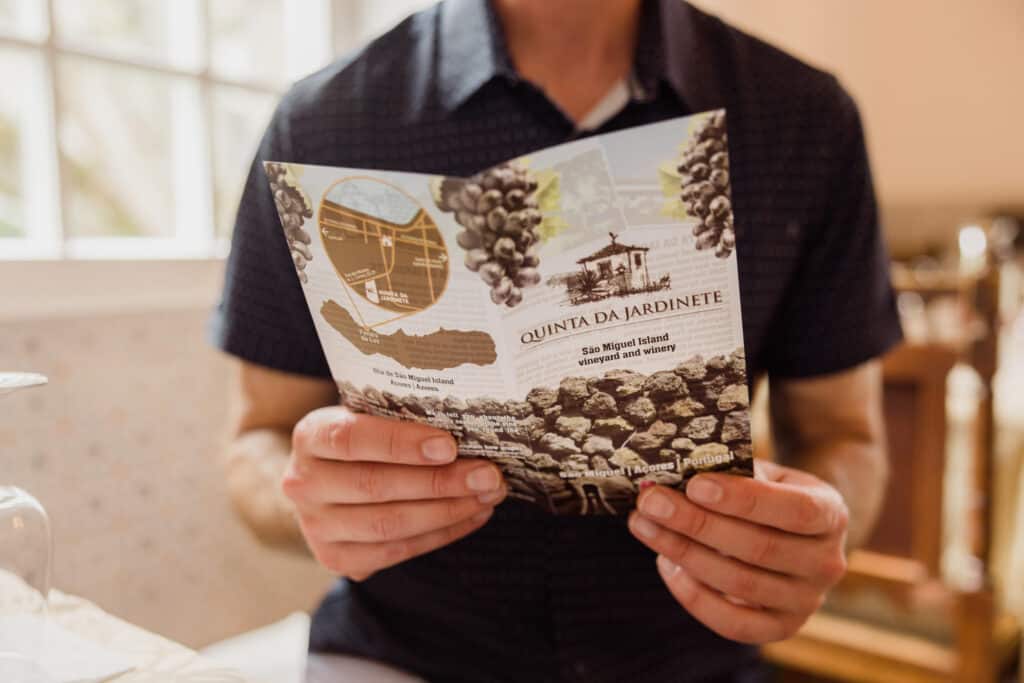
Azores Wine: Pico Island
Winemaking on Pico dates back to the 15th century.
The vineyards of Pico are unique and recognized as a UNESCO World Heritage Site, due to their remarkable landscape and historical significance.
The main grape variety cultivated on Pico Island is Verdelho, a white grape known for its crisp acidity and aromatic qualities. Verdelho thrives in the volcanic soil and cool maritime climate.
In addition to Verdelho, other grape varieties grown on Pico include Arinto, Terrantez, and Merlot.
The winemaking process on Pico Island in the Azores has evolved over the years, with modern techniques and equipment being employed to improve quality. However, traditional methods are still preserved, such as the use of stone-walled vineyard plots known as “currais.” These stone walls protect the vines from the harsh winds and create a unique microclimate that enhances grape quality.
Visitors to Pico have the opportunity to explore the vineyards and wineries, learn about the winemaking process, and indulge in wine tastings.
🍷 Click to Book: Vineyard Tour & Wine Tasting
🍷 Click to Book: Private Azores Wine Tour
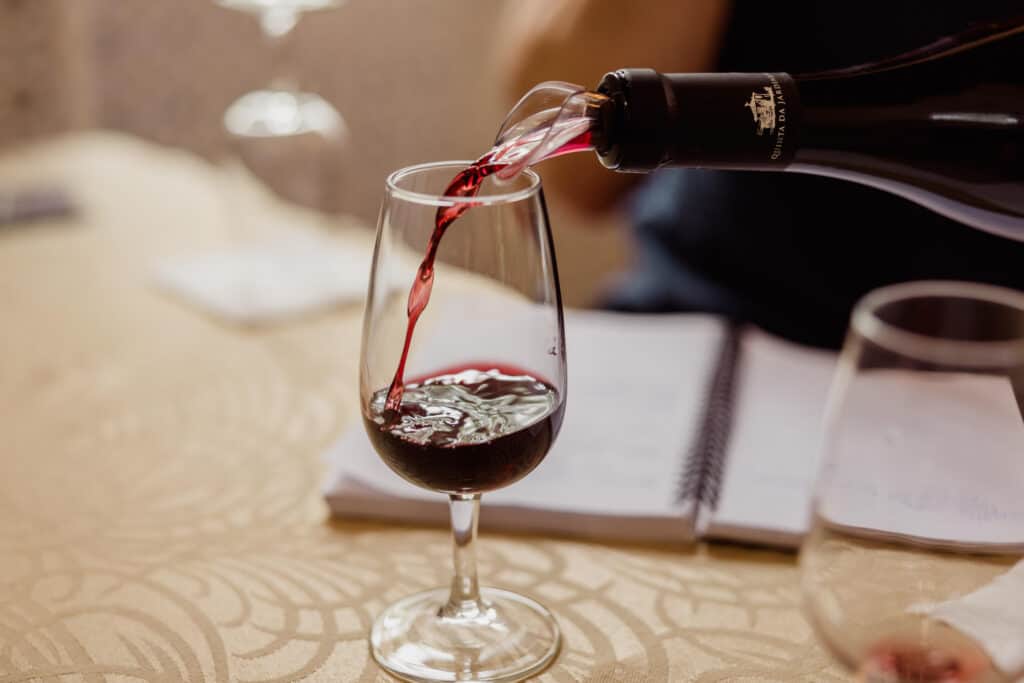
Vineyards on Pico Island
On Pico Island in the Azores, the vineyards are primarily located in the western part of the island, particularly in the UNESCO World Heritage-designated landscape of the “Criação Velha” wine region.
In addition to the Azores Wine Company, other notable vineyards on Pico Island include:
- Cooperativa Vitivinícola da Ilha do Pico (PICOWINES): Located in the parish of Madalena, this cooperative winery represents local grape growers and produces a range of wines.
- Adega A Buraca: Situated in the parish of São Mateus, Adega A Buraca is a small family-owned winery.
- Adega dos Biscoitos: Located in the parish of Criação Velha, Adega dos Biscoitos is a historic winery that dates back to the 16th century.
Azores Wine: Terceira Island
Winemaking on Terceira Island also dates back several centuries.
The main grape variety cultivated on Terceira is Verdelho, a white grape that thrives in the island’s volcanic soil and maritime climate. Other whites, plus red varieties like Merlot and Cabernet Sauvignon are also grown on Terceira.
Terceira Island also offers wine enthusiasts the opportunity to explore the vineyards and wineries through guided tours and tastings.
🍷 Click to Book: Private Wine Tour
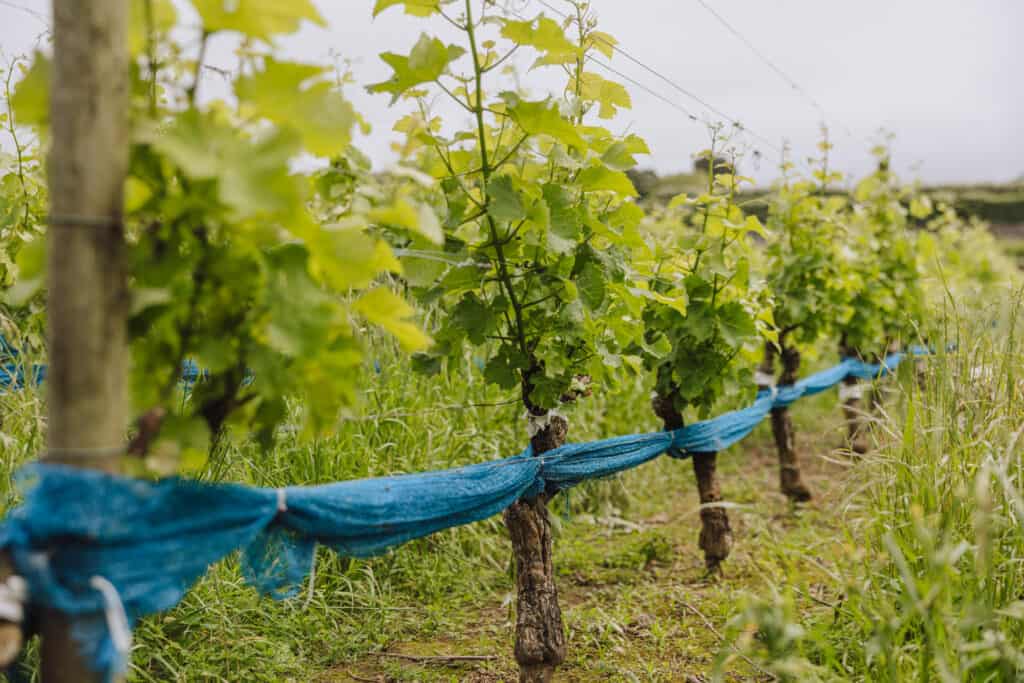
Vineyards on Terceira Island
On Terceira Island in the Azores, the vineyards are primarily located in the central and northern parts of the island, particularly in the parishes of Biscoitos, Doze Ribeiras, and Porto Judeu.
Some of the notable vineyards on Terceira Island include:
- Cooperativa Vitivinícola da Ilha Terceira (CVIT): Located in Biscoitos, this cooperative winery represents local grape growers and produces a variety of wines.
- Vinhos Brum: Situated in the parish of Doze Ribeiras, Vinhos Brum is a family-owned winery that produces a range of wines.
- Adega Simas: Located in Porto Judeu, Adega Simas is known for its production of wines from local grape varieties.
Azores Wine: Graciosa Island
The main grape variety cultivated on Graciosa is Verdelho, a white grape that creates wines with crisp citrus and fruit flavors. Graciosa’s wines are primarily dry and refreshing.
On Graciosa Island, the vineyards are primarily located in the central and southern parts of the island, particularly in the parishes of Santa Cruz and Luz.
Vineyards on Graciosa Island
Some of the notable vineyards on Graciosa Island include:
- Cooperative Winery of Graciosa: Located in Santa Cruz, this cooperative represents local grape growers and produces a range of wines.
- Pousada de Santa Cruz Vineyards: Situated near the village of Santa Cruz, these vineyards are part of a historic manor house and hotel.
- Vinhos Espadanal: Located in the parish of Luz, this vineyard specializes in organic wine production.
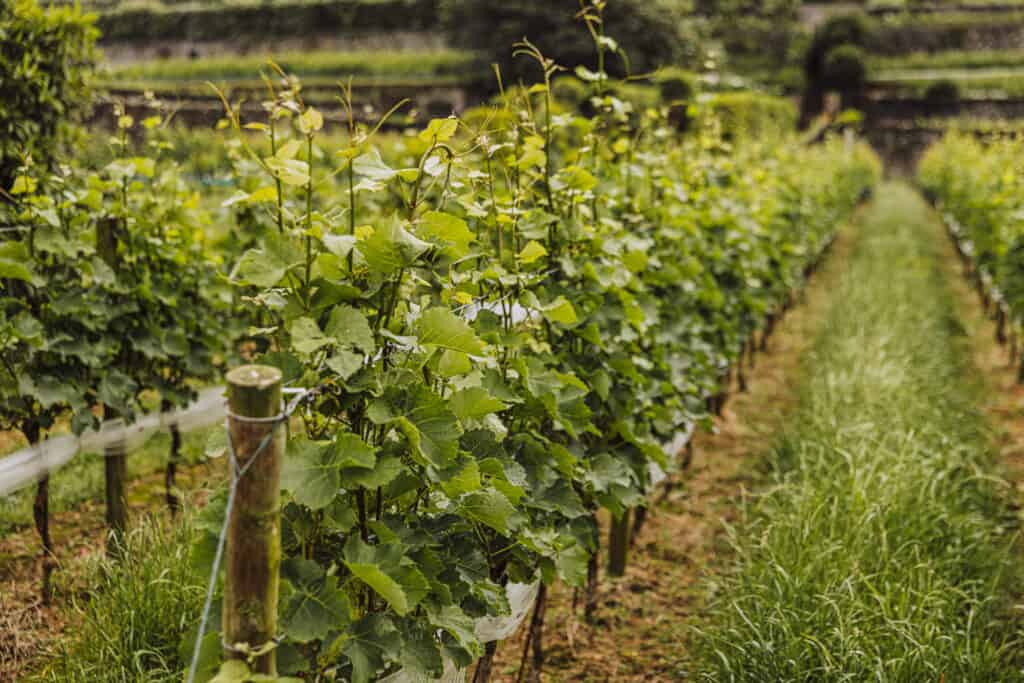
Azores Wine: Santa Maria Island
Santa Maria Island is known for producing white wines from grape varieties such as Arinto dos Açores, Verdelho, and Fernão Pires.
Vineyards on Santa Maria Island
On Santa Maria Island, the vineyards are primarily located in the southern part of the island, particularly in the parishes of Santo Espírito and Santa Bárbara.
Some of the notable vineyards on Santa Maria Island include:
- Adega Cooperativa de Santa Maria: This cooperative winery, located in the parish of Santo Espírito, represents local grape growers and producers.
- Quinta do Couquinho: Situated in the parish of Santa Bárbara, this vineyard is known for producing high-quality wines.
- Quinta dos Anjos: Located in the parish of Santo Espírito, this vineyard produces wines that reflect the unique terroir of Santa Maria.
Azores Wine: São Jorge Island
São Jorge is primarily known for producing white wines, particularly from the Verdelho grape variety.
Vineyards on São Jorge Island
On São Jorge Island in the Azores, the vineyards are primarily concentrated in the central and northern parts of the island, particularly in the parishes of Manadas, Norte Grande, and Urzelina.
Some of the notable vineyards on São Jorge Island include:
- Cooperative Winery of São Jorge: Located in Urzelina, this cooperative winery represents various grape growers and producers on the island.
- Fajã dos Vimes: This small village is known for its picturesque vineyards located on the slopes, which are accessed by footpaths and small trails.
- Manadas Vineyards: Situated in the parish of Manadas, these vineyards offer breathtaking views of the surrounding landscape.
Azores Wine: Faial Island
Faial is known for producing both white and red wines. Some of the grape varieties grown on Faial include Arinto dos Açores, Verdelho, and Merlot.
Vineyards on Faial Island
On the island of Faial, the vineyards are primarily located in the western part of the island, specifically in the area known as “Capelo.”
Some of the specific vineyards on Faial include:
- Adega do Vulcão: This vineyard is located in Capelo and is known for producing wines from local grape varieties, such as Arinto dos Açores and Verdelho.
- Vinhos Faial: This winery is situated in the Caldeira area of Faial, near the iconic volcanic crater.
- Quinta das Buganvílias: Located in Cedros, this vineyard cultivates a variety of grape vines, including Verdelho, Arinto, and Merlot.
Wrap: Azores Wine
Mainland Portugal is definitely more famous for its vineyards and wines, but the Azores Islands offer something unique.
Their small operations on islands in the middle of the Atlantic Ocean are really interesting to visit. You’ll definitely get a lot of one-on-one attention from the staff!
The combination of volcanic soil, maritime climate, unique grape varieties, centuries-old vineyard landscapes, and winemaking techniques combine to make Azores wines truly distinctive and sought after by wine enthusiasts looking for something out of the ordinary.
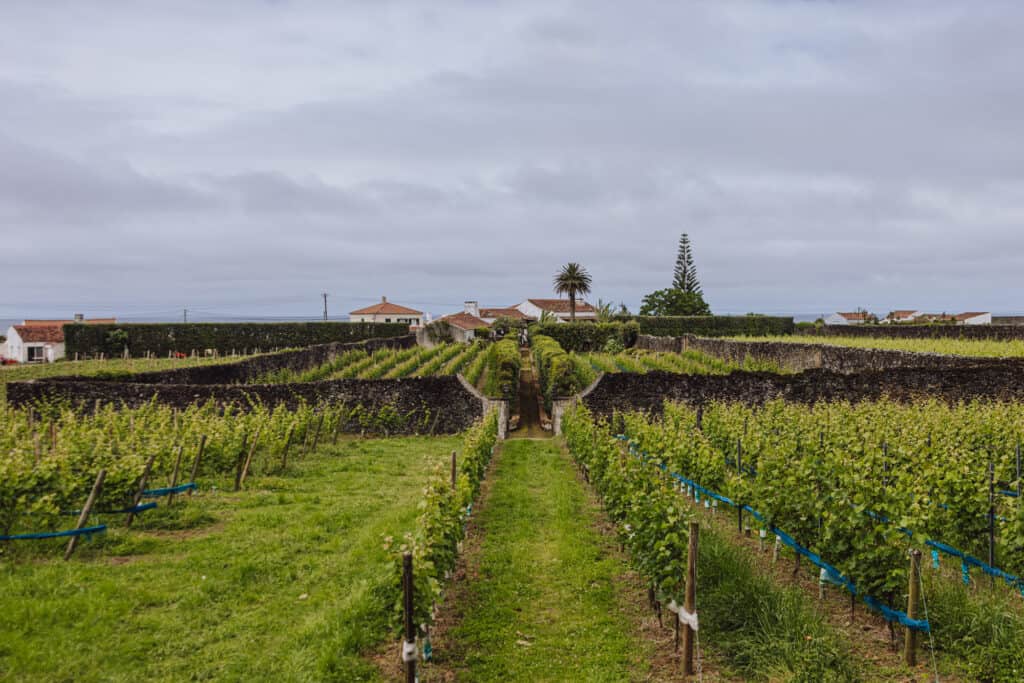
CHECK OUT OUR OTHER GUIDES TO THE AZORES:
